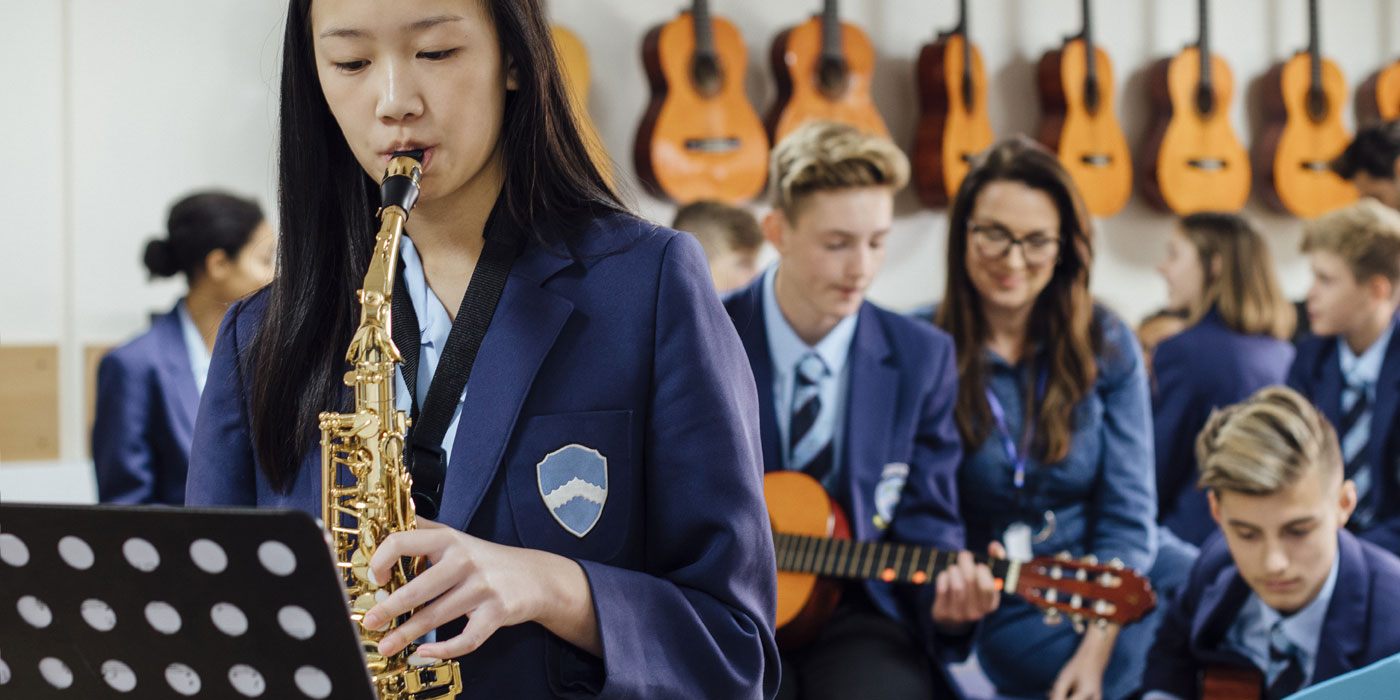
Your colleagues have found innovative and creative ways to use SmartMusic with their students and get the most out of their subscriptions. Outlined below are tips that range from how to get the most out of single-line method book assignments to how to turn warm-ups into a three-month-long quest! Discover assignment tips, tricks, and hacks to get more from your students.
Active Learning with SmartMusic
First, it’s important to remember that SmartMusic can be broken up into these three basic categories:
Practice Tools
SmartMusic gives you and your students access to vital practice tools—a tuner, metronome, and essential content including exercises, sight-reading tools, and select state scales. Additionally, custom content can be added and assigned to fit your needs via the Compose tool.
Feedback
SmartMusic immediately shows students the pitches and rhythms that they hit or miss via the red, yellow, and green note assessment. With this, students know what to work on to get the correct notes and rhythms. The comments box also provides an opportunity for teachers to provide personalized feedback, keeping the communication between teachers and students active at all times. It is here that you truly begin to work on the artistry of performance.
Guided Practice
Templates for assignments and rubrics make managing SmartMusic easy so teachers have more time to listen to their students’ best takes and offer personalized feedback.
General Setup Tips
- Require students to enter your email in their profile’s backup email field. This way, if a student forgets their password, you can help them regain access.
- Decide how to split your classes: you can create one class per ensemble, one class per instrument/voice type, by day of the week, or mastery level.
- Ensure your microphone settings are appropriate. Type ‘microphone settings’ in the help search box in the SmartMusic app to get all the information you need.
- Use the Chrome browser on all devices (except iPads, where you’ll use Safari). For more, see our specifications page.
Practical Tips
Model, model, model: This may seem very basic, but if you want your students to succeed using SmartMusic, you should demonstrate how it behaves, where the tools are, and how to get the best recordings. Having SmartMusic open during class at all times also provides you with everything you need, at a moment’s notice. When that teachable moment occurs, your resource is there! If you’re teaching virtually, be sure to share your screen so that students can follow along. When they see you using it, you are giving it value.
Automatic practice loop tempo increase: Show students how to loop specific measures of a song or exercise, and how to utilize the increase ____ beats per minute (BPM) feature. Depending on the piece, you may need to turn off the accompaniment when slowing down the music. Have students report back to you in the comments box with a description of what this practice tool and experience was like.
Rename your assignments: You are not obligated to use the default name that is pre-filled when you create a new assignment. Change the name—especially if you send many assignments from the same method book or piece. Decide on a naming format that makes sense to you, and rename the assignment to make it easier for you to manage your Gradebook. Make sure to rename before scheduling as you won’t be able to edit the name of the assignment after.
Assignment Creation Tips
Method book assignments: We all have the desire to assign all of the lines from a method book, asking students to progress through each exercise. While each line of music is important, pick the most important culminating line for your assignment that encompasses all of the preceding information and work from the page or chapter. Do not assign every line in the book as this will flood your Gradebook and the students’ assignments.
For example, if you’d like to assign line 18 from a method book, note in the assignment instructions: Before working on this piece to be submitted, practice lines 1-17 over the next several days. When you feel you are doing well with those lines, begin looking at the piece I have assigned for you to submit. I will be checking the practice analytics to ensure you are doing the assignments.
Also, let the students know that the grade is dependent on doing the preparatory work in addition to submitting the final performance.
Units: Build units of assignments to help you keep organized. Units won’t save you time when creating an assignment, rather they allow you to group assignments to save you time in the future. Units are great for tasks like sight-reading proficiencies, scale tests, required band pieces, etc.
One of the powerful ways of using Units is to create a performance assignment. Create a separate assignment for each piece of a performance, then lump them all into a Unit and assign the Unit to your students. Units can be reassigned and used year over year.
Scheduling multiple sight-reading assignments: Create a sight-reading assignment in Sight Reading Builder choosing parameters that fit your teaching needs, then select auto-generate. Sight Reading Builder will generate a new sight-reading exercise for each of your students based on your criteria. Every time you assign this assignment, a new sight-reading example is generated. Label the assignment so you know what criteria were used.
Comments box: Require your students to use it from day one! Make sure you model by giving comments back for each of your students based on your criteria. You can be encouraging your students anytime, anywhere, without other students in the room.
Create a summer practice class: You can assign material like warm-ups, exercises, method books, ensemble music you can play, etc. Nothing should be turned in so the students can’t “finish” the assignments. Try experimenting with material they don’t normally play in class or rehearsals, such as popular music.
Add practice incentive with basic, advanced, and mastery tempos: In your assignment instructions, indicate the tempos that will equate to basic, advanced, and mastery tempos. Schedule the assignment with the tempo options set to “At Least” or “Any.”
Utilize Rubrics: To encourage proper practice, rubrics are a powerful method for focusing students on details and informing them up front what exactly will be assessed. Rubrics can help organize and address individual skills and techniques such as articulations, dynamics, or intonation.
Create practice-only assignments: Date practice-only assignments for the end of the grading period so they appear at the bottom of your assignments, and explain to the student that they won’t be included in your overall grading process. Be sure to label them “DO NOT SUBMIT.” This is an opportunity for you to send out pieces that you’re considering, or to reward students for pieces that you notice them playing based on practice analytics.
Stay Consistent: Create assignments on the same day each week. Create due dates at the same time each week to keep both you and your students organized. Routines benefit everyone!
Creating assignments for percussionists: When teaching percussionists to roll, consider writing out the assignment you are planning on giving in Compose, substituting sixteenth notes in place of the roll.
Creative Assignment Suggestions
Warm-ups as long term assignments: Giving students exercise assignments to practice daily can yield remarkable results. One example is Long Tones:
- Assign the exercise Lo-Fi Long Tones Bb
- Instructions to include:
- Play this exercise daily.
- Listen to the accompaniment a couple of times before recording yourself.
- Save the very first recording to your desktop and label it “First-day LoFi [your name].”
- The day before the assignment is due, record yourself one more time, and before submitting, writing in the comment box what the experience was like for you and whether you hear anything differently, referencing the first-day recording.
- Play this exercise daily.
Suzuki for all: Utilize the entire Suzuki library with your students. Violin 1-3 International Editions feature Hilary Hahn performing these classic melodies that all students should be exposed to. Instrumental and vocal students can play and sing along with a professional artist. While you are looking at the violin method, explore the other Suzuki methods and see what may be adaptable for your students.
Small ensemble titles: Utilize the small ensemble library with your students. One on a part fosters independent skill growth and makes it easier for students to hear their parts, which will contribute to the overall improvement of your larger ensembles.
